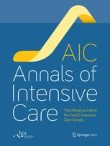Citation Impact 2023
Journal Impact Factor: 5.7
5-year Journal Impact Factor: 6.0
Source Normalized Impact per Paper (SNIP): 1.749
SCImago Journal Rank (SJR): 2.061
Speed 2023
Submission to first editorial decision (median days): 7
Submission to acceptance (median days): 91
Usage 2023
Downloads: 1,737,465
Altmetric mentions: 6,851
Predictors of haemodynamic instability during the changeover of norepinephrine infusion pumps
Changeovers of norepinephrine infusion pumps (CNIPs) frequently lead to haemodynamic instability. The aim of this study was to identify risk factors for haemodynamic instability associated with CNIP, independe...
